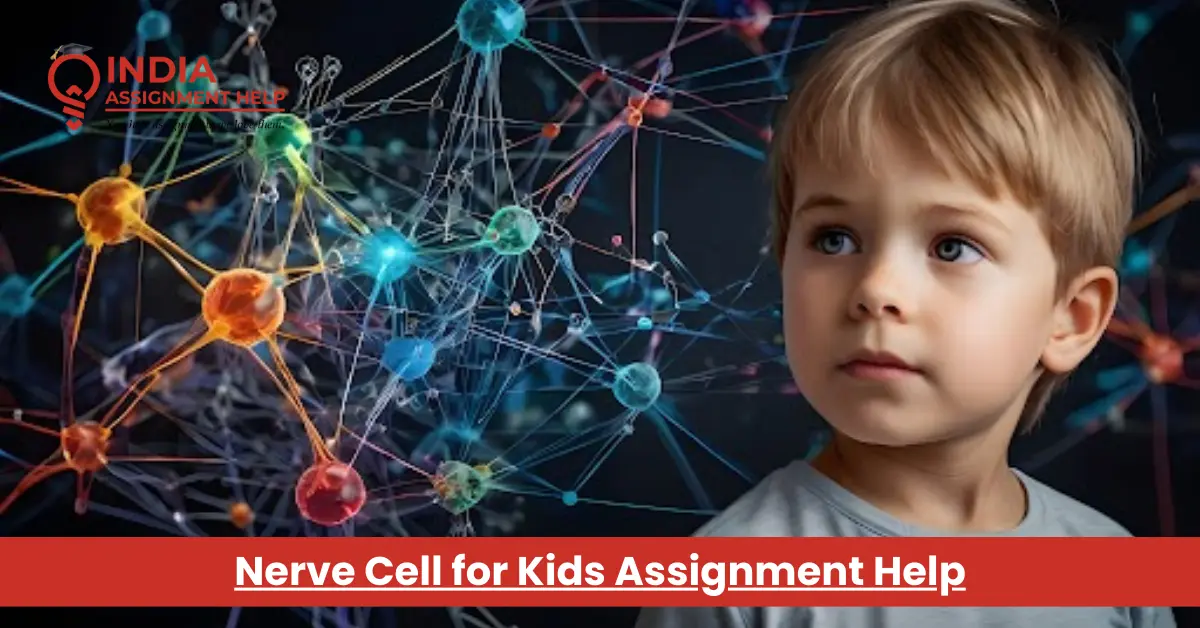Complete Guide on Nerve Cell for Kids Assignment Help

“Nerve cells for kids” are the fascinating little components of the body that play a significant role in everything we think and feel. Imagine tiny messengers crashing around your body to send essential signals from your brain to the different parts, helping you move, touch, see, and even remember things.
This weblog will take you on an excavating journey through the world of nerve cells and the nervous system for kids, exploring how it all works, why it's important and some interesting facts about the nervous system.
What are Nerve Cells?
Nerve cells, also known as neurons, are the primary units of the nervous system. These tiny star-shaped cells communicate with each other using electrical impulses and chemical signals. The human body has billions of neurons, all walking together to control every function.
The Structure of the Nerve Cells
Nerve cells have a unique structure that is perfect for their jobs. Each neuron has three main components.
Cell Body(soma)
This is the central part of the neuron, which contains the nucleus. The command centre processes incoming signals and decides what to do next.
Dendrites
These are branch-like structures that extend from the cell body. Dendrites receive signals from the other neurons and pass them to the cell body.
Axon
This long tin structure carries signals away from the cell body to the other neurons, muscles, and glands. A protective layer called a million sheet often covers the Axon, which helps the signal transfer faster.
How do Nerve Cells Communicate?
Nerve cells communicate through a process called synaptic transmission. When a signal reaches the end of an Axon, it triggers the release of chemicals known as neurotransmitters. These neurotransmitters crash into the tiny gap between the neurons called this synapse and bind to the receptors of the next neuron. This process continues until the message reaches its final destination.
The Nervous System for Kids
The nervous system in kids is like the body is a supercomputer. It controls everything from our heartbeat to our thoughts. The nervous system is divided into two main components:
Central Nervous System
The central nervous system includes the brain and the spinal cord. It processes information and makes decisions for the body.
Peripheral Nervous System
The peripheral nervous system is made up of nerves that branch out from the spinal cord and extend to all the parts of the body. It carries messages to and from the central nervous system.
Why is the Nervous System important?
The nervous system has become essential for survival. It allows us to react to the world, feel pain, experience joy, and even dream. Without it, we would be unable to move, think, or sense anything.
Understanding the nervous system helps us appreciate our bodywork and why we feel certain things. It can also help us make better health choices, such as avoiding habits that might harm our brains and nerves.
Different Types of Nerve Cells
There are three main types of nerve cells, each with specific roles in the nervous system:
Sensory Neuron
These neurons carry signals from sensory organs like ice ears and skin to the brain and spinal cord. They help us detect sensations like touch, pain, and temperature.
Motor Neuron
These neurons and signals from the brain and spinal cord to the muscles and glands control movements and bodily functions such as breathing and digestion.
Interneurons
This is found primarily in the brain and spinal cord. Interneurons connect sensory and motor neurons, helping us process information and coordinate responses.
Autonomic Neurons
These neurons control Involuntary functions like heart rate digestion and printing. They work automatically without us thinking about them.
Common Disorde Conditions in the Nervous System of Kids
Understanding the nervous system also means recognising the challenges it faces. There are multiple types of disorders that may happen to the nervous system of kids, which you can find listed below:
Multiple Sclerosis
This condition affects the protective covering of the nerve fibres, leading to communication problems between the brain and the rest of the body.
Parkinson's Disease
It is a type of disorder that affects movement, causing tremors, stiffness and difficulty with balance and coordination.
Epilepsy
A condition that causes recurrent sinuses is a sudden burst of electric activity in the brain that can temporarily affect how a person feels or acts.
Alzheimer's Disease
A progressive disorder that causes brain cells to degenerate and die, leading to memory loss and changes in thinking and behaviour.
Interesting Facts About the Nervous System: The Role of the Brain in the Nervous System
The brain is the control centre of the nervous system, with specific regions handling different functions:
Cerebrum
The most significant part of the brain is responsible for thinking, memory, speech and voluntary movements.
Cerebellum
Located under the cerebrum, it controls balance, posture and coordination.
Brainstem
This connects the brain to the spinal cord and controls essential functions like breathing, heart rate and sleep.
Hypothalamus
A small region in the brain that regulates body temperature, hunger, thirst and other autonomic functions.
What is the Sensory Nervous System?
The sensory nervous system is a part of the peripheral nervous system responsible for processing sensory information. It helps us experience the world through our five senses: smell, sight, touch, taste, and hearing. For example, when you touch a hot stove, the sensory nervous system sends a signal to your brain telling you that you have to pull your hand quickly.
What are Some Interesting Facts About the Nervous System?
There are some fascinating facts about the nervous system that one should know. Find a few of them listed below:
Fun Fact About the Nervous System
Do you know that the human brain has about 86 billion neurons? Each of these neurons can find thousands of connections, creating a complex network that makes you how you are.
Another Interesting Fact About the Nervous System
Yes, the spinal cord, part of the central nervous system, can sometimes act independently in your brain. This is why you can pull your hand away from something hot before you even realise it's burning you.
5 Interesting Facts About the Nervous System
- The brain weighs about 3 pounds but uses 20% of the body's energy.
- Nerve impulses travel at a speed of up to 250 mph.
- The longest nerve in the body is the sciatica, not running from the lower back to the toes.
- The brain can generate about 23 watts of power, enough 2 light up a small bulb.
- You have more new sales in your body than stars in the Milky Way Galaxy.
Nervous System Diagram for Kids
A nervous system diagram for kids is a great way to visualise how all the parts of the nervous system are connected. Diagrams typically show the brain, spinal cord, and venous branching out to the various parts of the body.
Understanding this diagram can help students and kids see how the nervous system controls everything from moving a muscle to feeling a touch.
Know the Fun Facts About Keeping A kid’s Nervous System Healthy
Keeping a kid’s nervous system healthy is vital for their overall well-being. Parents can do this by following some of the below-listed fun facts that can change their kid’s life:
Eat a Balanced Diet
Parents should focus on getting their kids to eat food rich in omega-3 fatty acids, like fish, nuts, and seeds, as these help support brain health.
Exercise Regularly
Physical activity increases blood flow to the brain and helps maintain healthy nerve cells. Therefore, getting kids to play outdoor games is very important for their growth.
Get Enough Sleep
Sleep is essential for the brain to process information and repair itself. Therefore, make your kid fall asleep by 9 pm as this is the ideal time for them to go to bed and develop.
Stay Mentally Active
Puzzles, reading and learning new skills can help keep your nervous system sharp. So, give your kid brain games instead of other indoor games.
Conclusion
The nervous system is a fascinating and complex network that controls everything we do. Nerve cells are essential for kids to understand how our bodies work, from superficial reflexes to complex thoughts. By learning about the nervous system and how to keep it healthy, we can appreciate the incredible power of our brain and nerves. Whether through fun facts, diagrams, or just understanding the basics, the nervous system offers a wealth of exciting and essential knowledge for kids and adults alike.
FAQs
Q1. What are nerve cells?
Ans. Nerve cells, or neurons, are specialised cells that transmit signals throughout the body, helping to control everything from movements to thoughts.
Q2. Why is the nervous system important?
Ans. The nervous system is vital because it controls all bodily functions, including voluntary actions like walking and involuntary actions like breathing.
Q3. How does the nervous system work?
Ans. The nervous system works by sending electrical signals through neurons. These signals travel from the brain and spinal cord to various parts of the body, directing them to do what is necessary.
Q4. What is the sensory nervous system?
Ans. The sensory nervous system is a part of the peripheral nervous system that processes sensory information from the environment, such as sight, sound and touch.
Q5. How can I keep my nervous system healthy?
Ans. You can keep your nervous system healthy by eating a balanced diet, exercising regularly, getting enough sleep, and staying mentally active.





